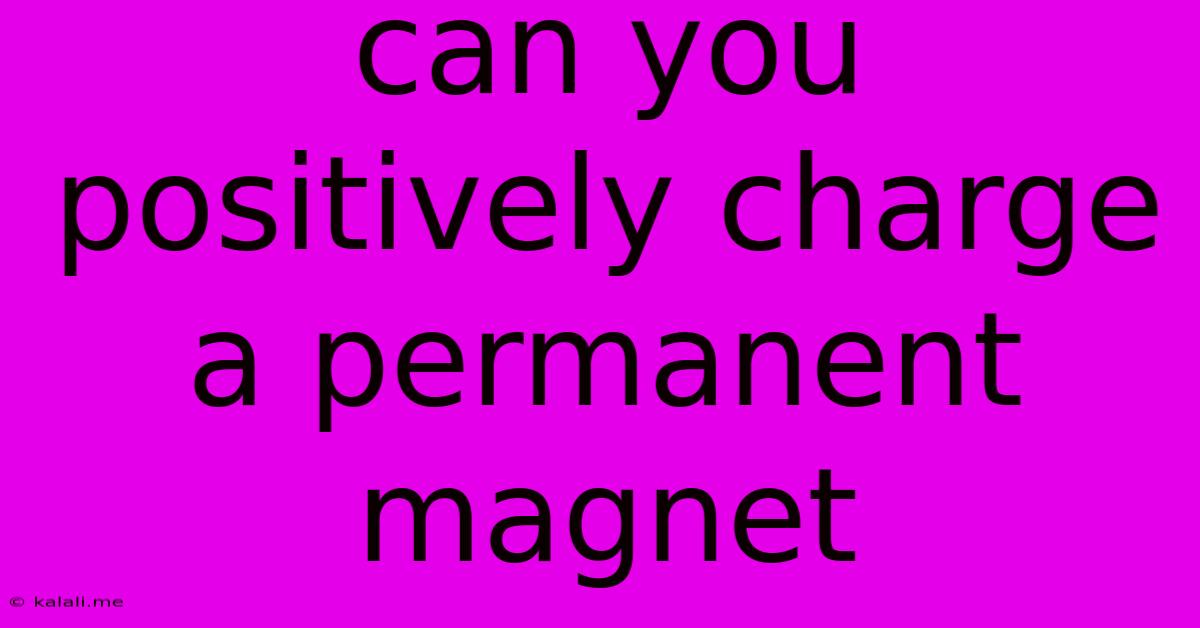Can You Positively Charge A Permanent Magnet
Kalali
May 24, 2025 · 2 min read

Table of Contents
Can You Positively Charge a Permanent Magnet? Understanding Magnetism and Static Electricity
This article delves into the intriguing question of whether you can positively charge a permanent magnet. The short answer is: not in the way you might initially think. While you can't change the inherent north and south poles of a permanent magnet, you can impart a static electric charge onto it. Let's explore the distinction.
Permanent magnets possess a magnetic field due to the alignment of electron spins within their ferromagnetic material. This alignment creates magnetic domains, which, when aligned, result in a macroscopic magnetic field with a north and south pole. This is a fundamental property of the material and cannot be altered by simply adding an electric charge. Trying to "positively charge" a magnet in the sense of switching its polarity is fundamentally misunderstanding the nature of magnetism.
The Difference Between Magnetism and Static Electricity
It's crucial to understand the difference between magnetism and static electricity. Magnetism arises from the movement of charged particles, specifically electrons, while static electricity is an imbalance of electric charge on the surface of a material. They are related but distinct phenomena.
- Magnetism: Generated by the inherent spin of electrons and their movement within atoms and materials. It's a force that acts on moving charged particles.
- Static Electricity: An accumulation of electric charge on an object's surface. This charge can be positive or negative, resulting from the gain or loss of electrons.
Charging a Magnet with Static Electricity
While you cannot change the magnetic poles of a permanent magnet, you can charge it with static electricity. This is done through methods like rubbing the magnet with a suitable material, similar to how you might charge a balloon by rubbing it on your hair. This process adds or removes electrons from the magnet's surface, resulting in a net positive or negative static charge. However, this static charge is entirely separate from the magnet's inherent magnetic properties. The magnet will still retain its north and south poles, regardless of its static electric charge.
The Implications of a Static Charge on a Magnet
Having a static charge on a magnet doesn't significantly alter its magnetic properties in most practical applications. The magnetic field remains largely unaffected. However, the presence of a static charge might influence the magnet's interaction with other charged objects or materials. For instance, a positively charged magnet might attract negatively charged objects.
In Conclusion: Separating Magnetic and Electric Properties
The ability to positively charge a permanent magnet refers to imparting a static electric charge, not altering its magnetic poles. These are distinct phenomena governed by different physical principles. While you can add a static charge, this doesn't change the fundamental magnetic properties of the magnet itself. Understanding this distinction is crucial for correctly interpreting the behavior of magnets in various situations.
Latest Posts
Latest Posts
-
Can You Pour Concrete In The Rain
May 24, 2025
-
What Is Incomplete Dominance In Genetics
May 24, 2025
-
God The Father God The Son God The Holy Spirit
May 24, 2025
-
Smoke Alarm Beeping With New Battery
May 24, 2025
-
Choose This Day Whom You Will Serve
May 24, 2025
Related Post
Thank you for visiting our website which covers about Can You Positively Charge A Permanent Magnet . We hope the information provided has been useful to you. Feel free to contact us if you have any questions or need further assistance. See you next time and don't miss to bookmark.